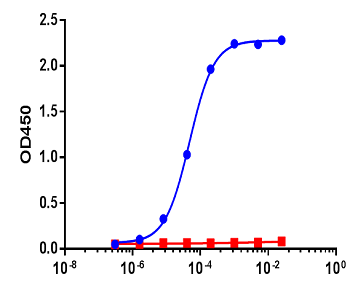
SARS-CoV-2 N Protein mAb (rec.(Capsi-1) (preservative free)

AG-27B-6007PF
ApplicationsELISA
Product group Antibodies
ReactivityVirus
Overview
- SupplierAdipoGen Life Sciences
- Product Nameanti-SARS-CoV-2 N Protein, mAb (rec.) (Capsi-1) (preservative free)
- Delivery Days Customer10
- Antibody SpecificityRecognizes and binds to recombinant SARS-CoV-2 N protein.
- ApplicationsELISA
- CertificationResearch Use Only
- ClonalityMonoclonal
- Clone IDCapsi-1
- Concentration1 mg/ml
- Estimated Purity>95%
- FormulationLiquid
- HostHuman
- IsotypeIgG1
- Scientific DescriptionCoronaviruses (CoVs) are enveloped non-segmented positive-sense single-stranded RNA viruses and can infect respiratory, gastrointestinal, hepatic and central nervous system of human and many other wild animals. Recently, a new severe acute respiratory syndrome beta-coronavirus called SARS-CoV-2 (or 2019-nCoV) has emerged, which causes an epidemic of acute respiratory syndrome (called coronavirus human disease 2019 or COVID-19). SARS-CoV-2 shares 79.5% sequence identity with SARS-CoV and is 96.2% identical at the genome level to the bat coronavirus BatCoV RaTG133, suggesting it had originated in bats. SARS-CoV-2 contains 4 structural proteins, including Envelope (E), Membrane (M), Nucleocapsid (N) and Spike (S), which is a transmembrane protein, composed of two subunits S1 and S2. The S1 subunit contains a receptor binding domain (RBD), which binds to the cell surface receptor Angiotensin-Converting Enzyme 2 (ACE2) present at the surface of epithelial cells, causing mainly infection of human respiratory cells. The N protein contains two domains, both of them bind the virus RNA genome via different mechanisms. - Recombinant Antibody. Recognizes and binds to recombinant SARS-CoV-2 N protein. Application: ELISA. Liquid, in PBS (pH7.4). Coronaviruses (CoVs) are enveloped non-segmented positive-sense single-stranded RNA viruses and can infect respiratory, gastrointestinal, hepatic and central nervous system of human and many other wild animals. Recently, a new severe acute respiratory syndrome beta-coronavirus called SARS-CoV-2 (or 2019-nCoV) has emerged, which causes an epidemic of acute respiratory syndrome (called coronavirus human disease 2019 or COVID-19). SARS-CoV-2 shares 79.5% sequence identity with SARS-CoV and is 96.2% identical at the genome level to the bat coronavirus BatCoV RaTG133, suggesting it had originated in bats. SARS-CoV-2 contains 4 structural proteins, including Envelope (E), Membrane (M), Nucleocapsid (N) and Spike (S), which is a transmembrane protein, composed of two subunits S1 and S2. The S1 subunit contains a receptor binding domain (RBD), which binds to the cell surface receptor Angiotensin-Converting Enzyme 2 (ACE2) present at the surface of epithelial cells, causing mainly infection of human respiratory cells. The N protein contains two domains, both of them bind the virus RNA genome via different mechanisms.
- ReactivityVirus
- Storage Instruction-20°C,2°C to 8°C
- UNSPSC12352203
